

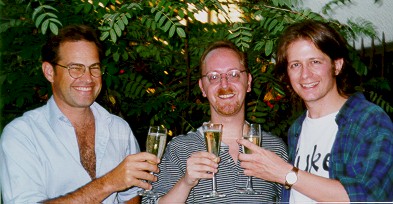 Eve of Departure
Eve of Departure
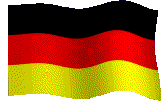 First stop, Beer-lin, a
city in the vortex of change. The city is vast, full of tumultuous
history, a vibrant nightlife and majestic museums and broad boulevards,
displaying a sense grandeur lacking in Seattle. My traveling companion
Julie (former Bastyr library assistant) and I stayed in a very central
pension near the Ku'damm, the tree-lined main shopping boulevard with
spacious sidewalks home to a plethora of outdoor cafes, merchandise
displays, street musicians and the bombed-out Kaiser Wilhelm Church, a
stark reminder of the devastation the city suffered 50 years ago.
First stop, Beer-lin, a
city in the vortex of change. The city is vast, full of tumultuous
history, a vibrant nightlife and majestic museums and broad boulevards,
displaying a sense grandeur lacking in Seattle. My traveling companion
Julie (former Bastyr library assistant) and I stayed in a very central
pension near the Ku'damm, the tree-lined main shopping boulevard with
spacious sidewalks home to a plethora of outdoor cafes, merchandise
displays, street musicians and the bombed-out Kaiser Wilhelm Church, a
stark reminder of the devastation the city suffered 50 years ago.
 PICTURE: At the
Brandenburg Gate
PICTURE: At the
Brandenburg Gate
We walked (and walked and walked) through the expansive Tiergarten (central park), where I climbed the 285 steps of the Siegessaeule (Victory Column, topped by the golden Winged Victory); browsed the Turkish market in Kreuzberg (Berlin is the largest Turkish city outside Turkey); passed through the historic Brandenburg Gate (symbol of German nationhood and site of joyous celebrations when the Wall fell) into former eastern Berlin, down its historic main avenue, Unter den Linden (where we were stunned to come across the British consulate swimming in flowers for Diana, whose funeral we saw in German); and saw a panoramic view of the city at night from the TV tower in Alexanderplatz. In the Nikolai Viertel, a restoration of old Berlin as it was centuries ago, we ate and drank along the Spree River. Among the museums we went to were the famous Pergamon (Near East antiquities) and Haus am Checkpoint Charlie (a terrific museum about the history of the Wall). We toured the grounds of Park Sanssouci in Potsdam, whose palaces and gardens were the playground of Frederick the Great.
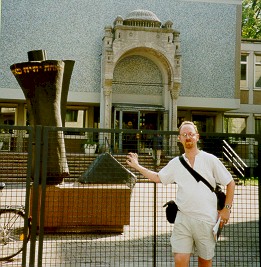 PICTURE (right):
At the Jewish Community Center
PICTURE (right):
At the Jewish Community Center
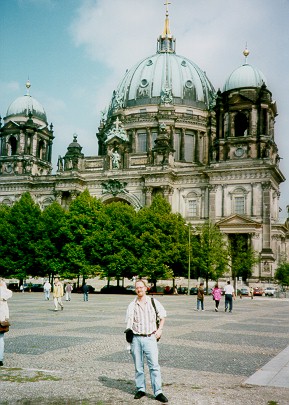 PICTURE (left): At
the Berliner Dom, Unter den Linden, East Berlin
PICTURE (left): At
the Berliner Dom, Unter den Linden, East Berlin
There is massive construction everywhere, especially Potsdamerplatz, once a busy crossroads, then severed by the Wall, now a field of dozens of cranes building the edifices of multinational corporations; and the Reichstag, which is totally enveloped in scaffolding (the German government moves to the new/old capital in 2000).
The distinction between East and West is blurring more and more in Berlin; indeed wherever we traveled it was hard to imagine life just ten years ago since the commercial West is such a strong presence already.
Both being Jewish, we made special efforts (throughout our trip) to see what renewed Jewish life was like since the fall of communism. I attended Shabbat services at a Reform congregation in one of many synagogues destroyed in the 1938 pogrom Kristallnacht (Night of Broken Glass), and visited the overgrown, vandalized old cemetery as well as the Jewish Museum in the gilded, restored New Synagogue (*new* meaning 1884).
 PICTURE: At the Haus
am Checkpoint Charlie
PICTURE: At the Haus
am Checkpoint Charlie
The subway system is daunting but as elsewhere we traveled, run on the honor system (you are to buy a ticket and validate it in case you are randomly checked -- we were never checked until we got to Budapest, where yours truly was fined all of $4.00). My German served me well long after we left Germany though I spoke almost as much Hebrew with local Jews and the hordes of Israeli tourists! We tried some local specialties, including Berliner weisse mit schuss (beer with syrup), bratwurst, doener kebap, etc., gorging ourselves (OK, myself) at the KaDeWe department store (largest in Europe, with a food court so large I got lost). Of course, everything was immaculate, including the spacious public restroom (complete with muzak, and which cleaned and disinfected itself after each use) except for the ever-present graffiti and the dust from construction.
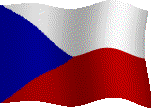 Next up, Prague: a
breathtakingly beautiful city of friendly people and exquisite
architecture at every turn, classical music concerts and theatre galore.
Prices are surprisingly cheap--we spent $15-$20 a night for lodging for
the both of us and regularly ate well for under $5.00.
Next up, Prague: a
breathtakingly beautiful city of friendly people and exquisite
architecture at every turn, classical music concerts and theatre galore.
Prices are surprisingly cheap--we spent $15-$20 a night for lodging for
the both of us and regularly ate well for under $5.00.
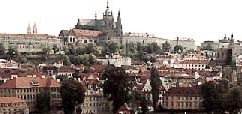 Prague escaped WWII relatively unscathed, and despite the hardships it has
seen since then, the atmosphere felt much lighter there than in Berlin.
40,000 Americans live there and I can see why! However, we were
disappointed to hear of the rampant discrimination against the Romany
(*gypsies*) in both the Czech Republic and Hungary, where landlords and
restauranteurs unabashedly refuse to rent to or serve them.
Prague escaped WWII relatively unscathed, and despite the hardships it has
seen since then, the atmosphere felt much lighter there than in Berlin.
40,000 Americans live there and I can see why! However, we were
disappointed to hear of the rampant discrimination against the Romany
(*gypsies*) in both the Czech Republic and Hungary, where landlords and
restauranteurs unabashedly refuse to rent to or serve them.
 PICTURE: Vaclavske Namesti, heart of commercial Prague
PICTURE: Vaclavske Namesti, heart of commercial Prague
The Old Town Square was a sight to behold, a broad plaza with a huge sculpture in the middle which serves as a hangout and resting place, ringed by ornate churches offering daily classical music concerts. Ate and shopped and checked my e-mail along Wenceslaus Sq., the site of massive demonstrations during the 1989 Velvet Revolution, now a booming commercial district. I'll never forget seeing Hradcany Castle overlooking the city, all lit up at sunset as seen from the Karluv Bridge over the Moldau, which is bustling with tourists, musicians and artists. We discovered oplatky and becherovka (a local sweet and the national liqueur) and brought home a small supply.
We went to a black-light theatre interpretation of "Alice in Wonderland," a marionette production of "Orpheus," a drag show in Czech, and toured the well-preserved and very active Jewish Quarter, featuring street vendors, Jewish museums, the old cemetery and a number of synagogues (one empty but for the tens of thousands of names of Bohemian and Moravian Holocaust victims carefully inscribed on every wall, upstairs and down).
Instead of an Orthodox Shabbat at the Alt-Neu Synagogue (dating from the 1200s), we attended very informal Reform services and spent the rest of the evening eating, drinking and talking with some North Americans and Czechs from the group; one was the sister of a Bastyr graduate (small world!) with whom we hit it off and met up with a few more times before we left Prague.
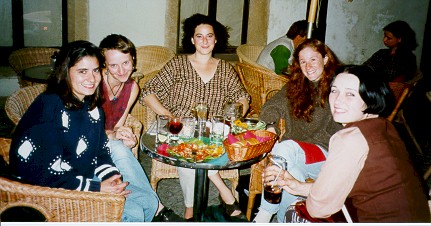 PICTURE: With new
friends, drinking becherovka after Shabbat
services
PICTURE: With new
friends, drinking becherovka after Shabbat
services
We took a day trip to Terezin (Theresienstadt), an odd experience, since the town itself served as a Nazi concentration camp (a prison fortress lies a short walk away), but now has a good museum about the war years (featuring art by children imprisoned there) and even a Jewish restaurant. Not many of the expelled residents returned after the war and there was a feeling of being on an eerily deserted movie set.
A daredevil bus driver managed to propel us safely to Cesky ("cheskey") Krumlov, a lovely riverside town in South Bohemia, where we stayed for a night in a funky hostel for $6 and toured the castle perched above the town. Back in Prague, we caught the night train to Krakow, on which my new camera was stolen. Very disappointing!, but I bought another the next morning in Krakow and I lost hardly more than 6 pictures. C'est la vie -- one of the risks of travelling.
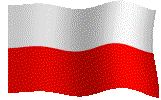 We spent most of the next several days
pleasantly in Krakow with two people we met on the train, a New
York fellow and an Australian woman living and working in London. We all
went to some amazing salt mines outside of town (complete with an
underground cathedral made of salt -- chandeliers and icons and all; also
an underground basketball court!)
We spent most of the next several days
pleasantly in Krakow with two people we met on the train, a New
York fellow and an Australian woman living and working in London. We all
went to some amazing salt mines outside of town (complete with an
underground cathedral made of salt -- chandeliers and icons and all; also
an underground basketball court!)
 PICTURE: Licking a
salt sculpture in the Wieliczka Salt Mines
PICTURE: Licking a
salt sculpture in the Wieliczka Salt Mines
We all then took in the Jewish Quarter. It was a shadow of Prague's, a sign of the devastation the war wreaked on Poland and its Jews: we attended Orthodox services in one of only two synagogues still functioning in a city whose pre-war population was one-third Jewish, sparsely attended mostly by older natives and younger tourists; followed by dinner and klezmer music at one of the Jewish cafes in the area, but the musicians were not Jewish; some antisemitic graffiti was also to be seen. It was nice spending those days with Karen and Chris, discovering restaurants and talking in jazz cellars.
Krakow's charming Old Town Square, ringed by cafes and home to the Cloth Hall (craft market) in the center, was full of pigeons and street musicians (even Andeans) but the most fascinating music was from the trumpeter who blows the same tune on the hour, day and night, from a church tower on the square -- stopping abruptly at the same point at which a trumpeter hundreds of years ago was shot in the neck by an arrow while warning of attack. We also explored the churches and caves at Wawel Castle (every place we went seemed to have its castle, market square, famous river and panoramic view). We were in Krakow during the legislative elections which brought Solidarity back into power, every available blank space being filled by election posters.
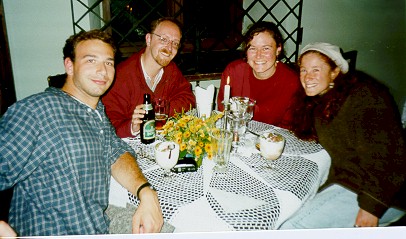 PICTURE: Dinner in the
Jewish Quarter of Krakow with new friends Chris and Karen
PICTURE: Dinner in the
Jewish Quarter of Krakow with new friends Chris and Karen
Then there was Auschwitz. On the one hand, it was a beautiful sunny day, pop music playing on the bus to this seemingly typical Polish town...yet passing the gallows and torture cells and crematoria along the tree-line lanes and in the well-preserved buildings and walking through gas chambers was almost surreal. Birkenau (the nearby second camp at Auschwitz) was immense in contrast, stretching as far as the eye could see and mostly in ruins. Barbed wire laced and ringed the camp; the famous train tracks ran through the gate, past the "selection" area where those too weak to work were sent to their deaths, ending at the now-ruined crematoria and a monument to the dead. We walked for what seemed like forever through the high grass and the barracks and the ruins. Words fail.
 PICTURE: Overlooking
Zakopane, Poland and the Tatra Mts.
PICTURE: Overlooking
Zakopane, Poland and the Tatra Mts.
After parting with Karen and Chris, we took a brief trip to Zakopane, a town in the southern mountains, which was a picturesque break from the city, commanding a great view of the Tatra Mts., where Julie stayed to hike while I went on to Pecs ("petch"), in far southern Hungary for some warmer weather. Since my train ticket from Krakow was only for Budapest, I had to convince the Hungarian conductor Laszlo who spoke no English to let me stay on and pay later. When we got to Pecs, he helped me store my bags, change money, check the train schedule back to Budapest and get a map! Chock-full of museums, Pecs was also home to a beautiful synagogue and several mosques (one now a church, and interesting mix of east and west).
 Back in Budapest, a large and
bustling city. It felt as large as Berlin but as friendly as Prague. It
was quite attractive in its own way, straddling the Danube, much as Prague
does the Moldau and Krakow the Vistula. The castle in the Buda Hills
(like the Prague castle overlooks the rest of the city) overlooks a busy
metropolis with excellent mass transit, a city absorbing Western culture
with as much vigor (or more) as any city we visited since Berlin. The
language was a challenge, by far the hardest of the four we had to deal
with (they got progressively harder as we travelled). On the other hand,
our hotel was by far the best we had yet, centrally located off broad
Andrassy St., very modern and comfortable, with a private bath (a luxury
we had mostly done without) and breakfast to boot, and all for $19 each
per night!
Back in Budapest, a large and
bustling city. It felt as large as Berlin but as friendly as Prague. It
was quite attractive in its own way, straddling the Danube, much as Prague
does the Moldau and Krakow the Vistula. The castle in the Buda Hills
(like the Prague castle overlooks the rest of the city) overlooks a busy
metropolis with excellent mass transit, a city absorbing Western culture
with as much vigor (or more) as any city we visited since Berlin. The
language was a challenge, by far the hardest of the four we had to deal
with (they got progressively harder as we travelled). On the other hand,
our hotel was by far the best we had yet, centrally located off broad
Andrassy St., very modern and comfortable, with a private bath (a luxury
we had mostly done without) and breakfast to boot, and all for $19 each
per night!
On arriving, I went straight to the large City Park and had my first of five soaks and three massages in the city's renowned Turkish thermal baths (three weeks of walking!). Julie and I climbed St. Stephen's Basilica for a panoramic view, shopped on bustling Vaci street, ate pastries at famous Gerbeaud's and the elegant New York Cafe (still in scaffolding from when a Soviet tank hit it in 1956) but worked it off walking, biking around the length of Margaret Island (a carless island park in the Danube) and of course sweating in the baths.
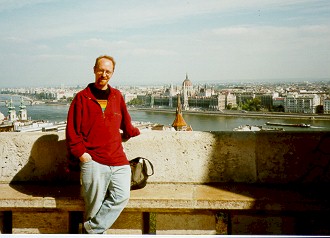 PICTURE:
Overlooking the Hungarian Parliament from the Fisherman's Bastion, Castle
District
PICTURE:
Overlooking the Hungarian Parliament from the Fisherman's Bastion, Castle
District
We took the funicular up to the lovely Castle District and Royal Palace and Citadella (painstakingly restored from the great destruction of WWII, featuring yet more great panoramas and a terrific Catering Museum). Another day, we hopped the train to the charming artist town of Szentendre just north on the Danube Bend: more shopping, an incredible Marzipan Museum (are you detecting a trend?) and relaxing with Tokaji and and Bull's Blood wine by the river. Tried some local dishes (goulash, palatschinken, even a bite of Julie's deer -- very adventurous for me!) and had a memorably fun night dancing at a local underground (literally) club, making friends with Nigerian students, Egyptian tourists and local Hungarians.
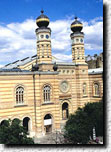
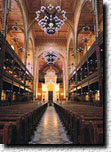 PICTURES: The Dohany Synagogue, 2nd largest in
the world, Budapest
PICTURES: The Dohany Synagogue, 2nd largest in
the world, Budapest
We joined an interesting van and walking tour of Jewish sites in the city (visiting some of the 26 functioning synagogues in what is now Eastern Europe's largest Jewish city). To finish in style, we went to La Boheme at the splendid golden Operahaz (great seats for $7.50); to four more Turkish baths (the most expensive at $6.00) including two massages; and finally Rosh Hashana services at Europe's largest (and world's 2nd largest) synagogue, recently restored to its former splendor.
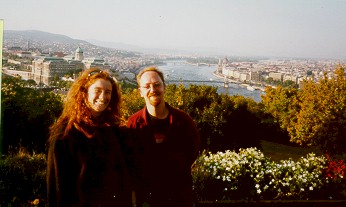 PICTURE: Overlooking
the Blue Danube from near the Citadella
PICTURE: Overlooking
the Blue Danube from near the Citadella
Some miscellany: The current megamovie in those parts is "Lost World"...People drink beer like water, eat a lot of pork in sauces, gorge on ice cream, take excellent public transit and still we saw hardly any overweight people... Every menu indicated how many grams of each dish were to be served and all beer mugs had a mark on the mug indicating the exact quantity...Platform shoes are all the rage for young women, the bigger the better... Berlin was very bike-friendly (down to special small traffic lights for bikers)...Get a table at a cafe or restaurant and it's yours for the evening, which it should be since service is deadly slow... Many pubs and restaurants are to be found in cellars (cheaper rent, I'm told)...
All in all, it was a great time. Believe it or not, am sparing you most of the details: how much fun (and stress) it was traveling without any advance accommodations, trying to communicate in English, German, Hebrew and of course Czech, Polish and Hungarian, and the pleasures of meeting people every day whom one would ordinarily never meet, beholding new and great things every day with nary a thought of bills or work or the Mariners.
Alas, back to the real world!

 Comments? Write me at RMIsaac@gmail.com
Comments? Write me at RMIsaac@gmail.com